A Rainbow, Great Food, Agnosticism, and Homesickness
/in Galway Spring 2024Hi.
I was given little instruction on what I needed to include in this blog other than to outline my initial impressions of Ireland and my study abroad experience. So, I’ll use that as an excuse to exercise creative freedom concerning how I’ll address my initial impressions. However, I believe this blog ought to start with a quick recounting of my departure from home and arrival in Ireland. The trip was uneventful, which is a great thing when traveling. I sat beside an old lady on my flight from Sioux Falls to Chicago, and we talked briefly. She was very excited to hear that I was studying abroad and studying to serve in the gospel ministry. I include this because I’m always appreciative when someone encourages me to continue training for public ministry, especially strangers.
After a lengthy layover in Chicago, I boarded my flight to London and got a grand total of three hours of sleep on the flight. I can’t complain too much because that’s excellent for an airplane. It also allowed me to watch the sun slowly rise over London as the plane came close to landing. I find it interesting to watch how European cities and streets snake in violent directions compared to the uniform grids of cities in the US. Once safely in London, I had to go through security again and boarded my final flight to Shannon Airport. It was brief, and I landed without any problems. In fact, once I retrieved my checked bag, it was the fifth bag that appeared at baggage claim– a miracle!
I met up with the group I am studying abroad with through ISA (International Studies Abroad), and we took a taxi to our housing. On the drive over, it suddenly started raining but stopped a couple of minutes later. After the rain stopped, the sun came out, and a rainbow appeared in the sky! It had been forever since I had seen one and it was a great reminder of God’s promise to never flood the world again! Once we arrived, our group leader, Karen, took us to buy bedding and other basic amenities. After that, I spent time getting unpacked and trying to stay awake to adjust my circadian rhythms to my new environment.
—
As a student of MLC, I was required to take a class called Fit for Life. Although I don’t remember much from the class, I do remember learning about the six different types of health: Physical, Mental, Emotional, Social, Environmental, and Spiritual. I think these six health aspects are a perfect starting place for reflecting on my initial experience.
- Physical
Physically speaking, besides a minor cold I’ve developed in the past day, I feel healthy. One of my fears before arriving in Ireland was being unable to locate food that I would be able to eat due to my intolerance to gluten and lactose. I had nothing to fear. I have many options for buying healthy, nourishing food within one mile of my housing. Eating out has been a little tricky because many of the staple dishes of Irish restaurants include dairy and gluten.
Nonetheless, I love cooking for myself because it’s easy to control portions and ensure that I won’t contaminate my food with allergens. I’ve also had the privilege to buy a pass for the school’s gym, which has everything I could want and more. So far, I’ve consistently gone to the gym three days a week and lifted weights. This has been great, but what amazes me is how much I walk everywhere. I live about one mile from my University, so I’ve easily walked an average of 15,100 steps per day (about 8 miles per day).
- Mental
When it comes to my mental health, I know I’m doing well because I’m able to think clearly and keep a level head. I’ve been getting plenty of sleep here (about 8 hours per night), which has helped.
- Emotional
Emotionally speaking, I’ve had some successes and failures. The most significant success I’ve noticed is my ability to remain calm despite the uncertainty regarding the academic registration process here in Ireland. In Ireland, they only have you register for classes once you arrive on-site, and even then, classes start before your registration process is complete. When I started the registration process on Friday the 5th, I quickly discovered that I couldn’t take two of the four classes I had been approved to take by MLC before I left for Ireland. However, I was able to explain the situation to Dean Clemons at MLC, and he was able to provide me with alternative options. I want to give a huge thanks to both him and Professor Grubbs for quickly helping me resolve the issue!
Additionally, this uncertainty has already led to me missing a class (in my mind, a grievous sin) simply because I couldn’t access adequate information to know where the class would take place. I’ve discovered that the first week of classes is considered optional, so it’s not a big deal, but I still don’t like missing out on information, especially at the start of a semester. Despite the turmoil, I’ve stayed calm and gone with the flow. I should also note that the Irish education system cares less about class time and more about independent learning. This is a struggle for me to adjust to, but the benefit is that I don’t have any class on Fridays!
While this has been ideal, the biggest challenge that I’ve been facing so far is homesickness. For the most part, I feel great during the daytime (when the sun is out), but at night, once I run out of things to do and stay busy, I start to feel the sadness creep in. As embarrassing as this is, I’ve also been experiencing random bouts of missing my home and family during the daytime that drive me to tears. I seldom cry, but I’ve cried more in the past week than in the past three years combined. This has been the most homesickness I’ve ever dealt with, even more than when I left home for the first time for high school and college. I think it’s because I’ve developed a greater appreciation for my family and friends in the past year. I miss my parents, sister, and roommates, Rees and Adam. This is the first time in my life that I’ve been able to confidently say that I feel like I belong in a friend group, so leaving them has been very hard on me. In fact, I’m tearing up a little bit as I write this right now. I’m just so thankful for them, and even though I’m missing out on a semester with them, I know I’ll appreciate the time I spend with them when I return even more than I would’ve before. However, one of the blessings of the homesickness is that it’s caused me to read my Bible and pray more (more on that in a bit).
- Social
My social life has actually been going better than I expected. When I arrived, I met a group of students from all over the US because we are all studying abroad through the same company. This group of people has been super lovely, and despite our differences, we’ve bonded over the fact that we are all studying abroad and struggling with similar things. In the first week that I’ve been here, we’ve all gone out together numerous times for dinner or drinks. This is an interesting comparison point between the US and Ireland cultures. Generally speaking, in the US, when you refer to going out for drinks, you’re going out for 1-3 drinks. In Ireland, when someone says they’re going out for drinks, they’re going out for 5-8 drinks. I honestly don’t understand how they do it! The drink prices are ridiculously expensive (almost 6 USD for a pint of beer and 10 USD for mixed drinks), so I’ve avoided drinking beyond 1 or 2.
It is effortless to meet people here as long as you’re willing to be the person to speak first. From my (very limited) experience, people rarely will address you first, but if you smile and greet them and ask how they’re doing, they’ll happily respond. I’ve met several people this way, either in orientation or in classes. I have started forming a friendship with a Canadian named Josh (from Winnipeg), and the pleasure of getting to know him has been that he is very curious about God. He’s admitted to me that he’s jealous that I can have faith in God, so I’ve used this as an opportunity to share the gospel message a couple of times. He was also curious about why and how Lutherans differ from Catholics, so I got to teach him about the Reformation! Thanks be to God for allowing me to share the good news about Jesus!
- Environmental
The environmental aspect (my surroundings) has probably been one of my most eye-opening and culturally shocking experiences. I am definitely outside of the WELS bubble. This isn’t necessarily bad, but I think it contributes to my homesickness. I was quickly reminded of this Bible passage from 1 Peter 2:11, “Dear friends, I urge you, as foreigners and exiles, to abstain from sinful desires, which wage war against your soul.” Obviously, I am a foreigner here in Ireland, but I am also a foreigner of this world, simply on a journey toward my heavenly home. It’s easy for me to forget that I am a foreigner on earth when I’m at home. Being in Ireland (and especially experiencing homesickness) has caused me to remember where my true home is. The reason that I was reminded of this verse is because of the experiences I’ve had living in the “post-Christian” society that is Ireland. I have already heard several malicious quips made about either the Catholic church or Christianity as a whole….
At my orientation, we had a “sexologist” come and speak to us about consent, but with very vulgar descriptions and sayings that I honestly can’t repeat. It felt like I was the only person who wasn’t laughing. When I walk around campus, I constantly hear people swearing. I’m generally not that sensitive to swearing, but because I’ve been used to walking around MLC’s campus and not hearing it carelessly used, it’s taken me by surprise. Several of the guys my age that I’ve met have bragged about their sexual exploits, others have bragged about how much they can drink, and the list could go on and on with all of the sins that I am surrounded with.
All of this has not caused me to get angry, but it’s caused me great grief. I am constantly reminded of Jesus’ words on the cross, “Father, forgive them, for they do not know what they are doing” (Luke 23:34 NIV). It could be my own ignorance, but it feels as though the people around me are unaware of their constant sin. I feel horrible for them, and I wish that they would come to recognize their sins and that Jesus is their savior. At the same time, what I’ve discovered is that (almost) everyone seems to be very curious about the idea of God– I’m surrounded by agnostics. This has been incredibly encouraging. 1) I see the great need for the gospel, and 2) people have open ears and want to learn. I pray that by the power of the Holy Spirit, I can be a tool that can be used to share the gospel with those who need it. After all, that’s what I’ve been spending all my time at MLC for, right?
- Spiritual
A few months ago, I attended a morning chapel service at MLC, where Professor Waldschmidt preached a sermon about God’s deliverance in times of need. He said (more or less) this: “I don’t know about you, but I need to be saved from something every day.” I don’t know why this statement sticks out, but I remember pondering it as I sat in chapel that day. As Christians, we know that we perpetually need God’s redeeming grace. But at the same time, Professor Waldschmidt also talked about how there are things in our everyday lives that we need God’s help. This is something (perhaps because of my self-reliant nature) that I have come to understand and realize in the past week.
As someone from a very independent society that recognizes self-reliance as the pinnacle of human accomplishment, I struggle with knowing that every good thing I do is from God and that without his power, I can do nothing. I cannot do everything on my own. It’s hard to see when you’re accomplishing everyday, ordinary tasks. I mention this because I have been struggling with adjusting to living abroad. Because of this, I find myself praying and asking for God’s help with the simplest things. Here are some real prayers I’ve had in the past couple of days: “Dear Lord, please keep me safe when I cross through traffic to go buy groceries. Amen.” “Dear Lord, help me remember where I have class. Amen.” “Dear Lord, give me the grace to not burn my food as I cook it. Amen.”
It’s an excellent reminder for me (and possibly you) that we must constantly rely on the Lord. And while I’ve been relying on God for the minuscule things, I’ve also been relying on him for the gigantic things. When I feel lonely, depressed, miss my family, or on the verge of tears for no apparent reason, I call out to God and ask for him to take away my pain. God has answered, not always right away, but I can trust that things will get better. In fact, when I visited the University of Galway’s chapel yesterday, I found two prayer cards in the lobby. I’ve attached a photo of them because I’ve been praying these prayers constantly and felt God was speaking to me with the line, “Give me the hope to believe that things will work out and that all will be well again. Amen.” I can confidently say God will make everything work out in the end (Romans 8:28), even if it’s hard to see amid my struggles.
Also, a quick note: I’ve kept up with my daily Bible reading plan, worshipped at the local Presbyterian church on Sunday morning, and attended morning mass with the Catholics twice. Both have benefited me, even if they aren’t WELS churches. I pray that God will continue to use both as a blessing to strengthen and keep me in the faith. Amen.
—
Thanks for reading my blog; I hope you enjoyed it. I know it was long, and there’s so much more I could have talked about, but this was the most relevant. Please continue to pray for me as I study abroad.
“And the peace of God, which transcends all understanding, will guard your hearts and your minds in Christ Jesus. Amen.” Philippians 4:7
Here’s a description for each photo attached below:
- The rainbow I saw right after I landed in Ireland.
- The prayer cards I’ve been praying (almost without ceasing)!
- The inside of the Galway cathedral where I’ve gone to Catholic mass.
- The outside of the Galway cathedral.
- A random alley near the city center that capture the spirit of Galway.
- A photo taken on a foggy morning walk to class.
- The inside of the campus pub. Perhaps MLC should team up with Schell’s to have it’s own campus bar??
- “American-style” peanut butter– tastes just like Jif, but without all of the added sugar!
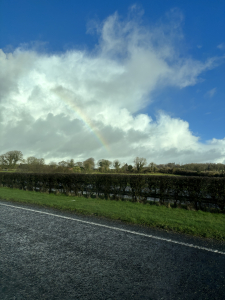
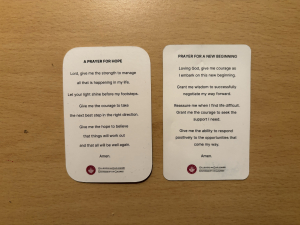
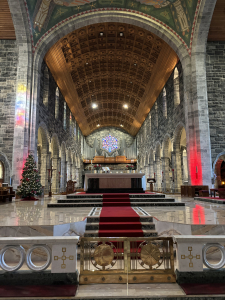

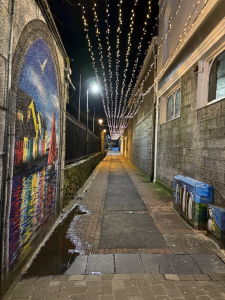
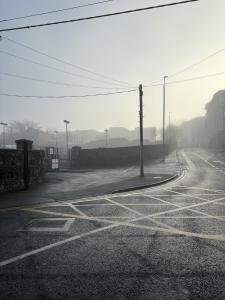

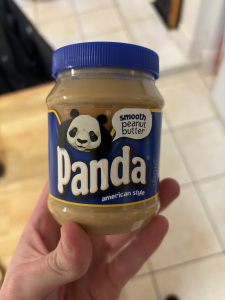
My Goals and Expectations for Studying Abroad in Galway, Ireland
/in Galway Spring 2024Hello. My name is David Fenske. I am a Junior at Martin Luther College, double majoring in secondary English and Spanish Education. If you’ve never met me before, here’s a quick biography of who I am:
I was born and raised in Brookings, South Dakota. I attended Great Plains Lutheran High School, and after I graduated, I studied Agricultural Business at Iowa State University for one semester. After a change of heart (and a calculus class), I realized I needed to change my path. I decided to transfer to MLC at the start of the Spring 2022 semester. Since then, I’ve loved my experience at MLC and developing the skills to become a called worker. Here’s a not-so-brief list of my interests (in no particular order): Reading, writing, literary criticism, exegesis, weightlifting, discovering obscure music, fishing (if they’re biting), baking, snowmobiling, target shooting, good conversation, telling stories, studying, learning Spanish, being in nature, teaching, and philosophy.
That said, am I scared about my study abroad experience in Ireland?
No.
Am I nervous about my study abroad experience in Ireland?
Yes.
I should expound on this. Essentially, I have no fear when it comes to studying abroad; I studied abroad in Buenos Aires, Argentina, in the summer of 2023. I also know that God will guide and protect me on this journey (read Romans 8:28, Isaiah 41:13, Jeremiah 29:11, etc.). The combination of these two things gives me confidence that I am capable of studying abroad and eliminates my fears. But that doesn’t mean I’m not apprehensive about certain aspects of my upcoming experience. Although I’ve studied abroad before, I’m stepping into a completely new world and culture. I will be far away from anyone I know (my nearest friends are about 500 miles away from me in London). I’m also celiac and lactose intolerant, making locating food that I can eat somewhat tricky at times. However, I am contemplating beginning a carnivore diet, and the idea of that is alluring because it would make my life much simpler and reduce the risk of me accidentally becoming sick from eating something.
Additionally, I won’t have the luxury of being able to worship in a WELS church on Sunday mornings or go to daily chapel services. In fact, there’s only one Lutheran church on the entire island of Ireland (located in Dublin), and they still have their church services in German! This means I will have to be much more disciplined in my relationship with God, a challenge I’m ready to face head-on (more on that later). Finally, I am nervous about my host university’s class structure and style. It’s no secret that MLC gives an exorbitant amount of homework compared to other colleges in the US. However, I don’t mind the homework too much because it keeps me on track and engaged with my classes. According to my research, they hardly have any homework in Ireland, and learning is a much more independent process. This challenge makes me uneasy because I must be much more disciplined to ensure I study enough and stay engaged with my courses. Consequently, I will have to be more of an active learner than a passive one.
I have been asked to write about my goals and expectations for my study abroad experience in Galway. Before I get into that, I should address two things.
- What is my overarching philosophy towards studying abroad?
- I am a firm believer in the idea of continuous improvement, especially concerning the self. I desire to improve myself each day that God gives me on earth. My philosophy towards studying abroad embraces this idea of self-improvement. I will continue the things I do for self-improvement, simply in a new location. This is contrasted with the (in my opinion, weaker) thought that I should study abroad to become a better person. I know there will be tremendous benefits and blessings that flow from my study abroad experience, but rather than try to define or describe exactly what those will be, I’d rather take them as they come. I believe that it would be a floccinaucinihilipilification to try to definitively predict what benefits I will gain from studying abroad before I’ve experienced anything. I will focus on the things I know I can control to improve myself and simultaneously reap the (currently unknown to me) blessings of studying abroad in Ireland. I’m excited to live with the ambiguity of not knowing what lies ahead.
- How do I define “goals” vs. “expectations”?
- In seventh grade, I was asked to write goals for the first time. My homeroom teacher, Mr. Kirchner, taught me the concept of SMART goals. SMART is an acronym that stands for specific, measurable, achievable, relevant, and time-bound. Writing SMART goals is hard, but it distinguishes between wishing and doing. Therefore, this is the definition I use for goals.
- In my opinion, expectations are different from goals simply based on specificity– expectations are my vague desires of what I want to occur in my study abroad experience. Unlike goals, I cannot predict or naturally attach quantifiable requirements to expectations.
Now I feel I am ready to disclose my goals and expectations for Ireland and their explanations.
Previously, I mentioned “the things that I do for self-improvement.” These are relevant daily expectations I have for myself, regardless of whether I’m studying abroad or at home. They include journaling, voluntary reading (i.e., reading for fun), reading my Bible, prayer at the start and end of the day, basic hygiene, physical exercise (weightlifting three days a week & walks), and intentional conversation with others. All of these help me keep my sanity and give me a sense of purpose, even if other things in my life are awry.
What are my goals for myself during my study abroad experience?
- By the end of my time in Ireland, I will receive an A (or the equivalent grade) in all of my classes.
- By the end of my time in Ireland, I will be able to bench press 70 kilos for 5 reps, back squat 90 kilos for 5 reps, and RDL 115 kilos for 5 reps.
- By the end of my time in Ireland, I will have made at least two friends from a country outside of the US.
- By the end of my time in Ireland, I will have traveled to at least four European countries.
- By the end of my time in Ireland, I will have read at least 8 books for fun (see my reading list at the bottom of the blog).
What are my expectations for myself during my study abroad experience?
- I will become more resilient and adaptable to complex situations with various elements out of my control.
- I will become more self-aware and strengthen my ability to self-reflect.
- I will become better at both inter- and intra-personal communication.
- I will learn how I could potentially integrate elements of the Irish educational system into my future classroom.
- I will learn more about the history and culture of Ireland, potentially altering my worldview and the way I think.
- I will be ready to witness my Christian faith to those with whom I develop relationships within Ireland.
All in all, I am incredibly excited about my opportunity to study abroad. I cannot wait to gain new experiences and add new stories to my repertoire. May God grant me the strength to live each day for him. Please pray for me and others studying abroad this semester.
One final musing for you to ponder: If something won’t make a great story someday, is it worth doing?
As promised, here’s my personal reading list for the semester:
- Extreme Ownership, Jocko Willink and Leif Babin
- On Writing: A Memoir of the Craft, Stephen King
- For Whom The Bell Tolls, Ernest Hemingway
- Pastoral Song: A Farmer’s Journey, James Rebanks
- Brave New World, Aldous Huxley
- Lonesome Dove, Larry McMurtry
- Wise Blood, Flannery O’Connor
- One Child, Mei Fong
Peanut Butter Marmalade
/in London 2023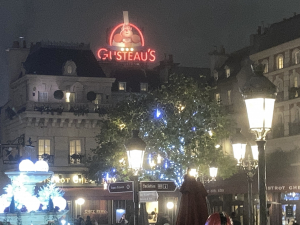
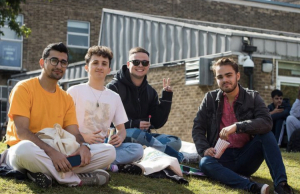
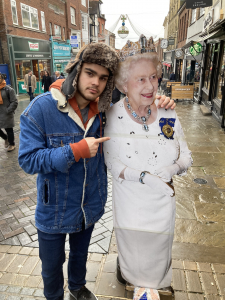

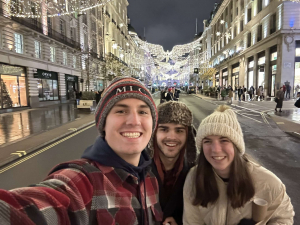
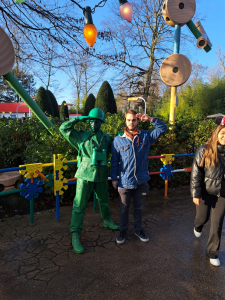
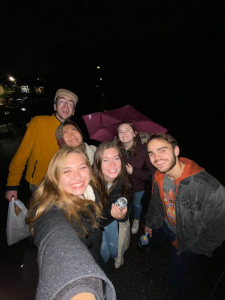
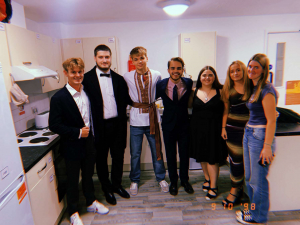
Above: a compilation of friends, new and old
This past week, I went to Paris and it really gave me an appetite for watching the movie Ratatouille (a very American reaction to Paris, I know). The movie is about a lot of things. The most obvious themes are the importance of art and that art can come from anywhere. This time around though, the side plot between Remy and his dad particularly struck a chord with me. Remy does not want to live the life of a rat. He wants to cook like humans do, but being a rat, he cannot pass as a human. It highlights his perceived absence of identity as neither rat nor human, and a tug-of-war between Remy’s origins and his current status in life. Can he really be both things at once? Just before leaving America, I felt like there was something outside small-town life that I was missing. I didn’t exactly know what it was, but I thought that before I went on with my life, I needed to know if there was anything out there that I’d need to be “more fulfilled.” I thought, what if on the off-chance I have a “Remy moment?” The strange part of it was though, that unlike Remy, the life I was currently living made me anything but unhappy. I knew how joyful teaching makes me, how passionate I am about literature, how satisfied I would be working with kids the rest of my life and how great of friends and teachers I have. As it turns out though, there was something I was lacking. I was missing the thing that Ratatouille’s hardened critic, Anton Ego, so desperately craved: perspective. Yes, I have experienced an innumerable about of blessings abroad, but to me, the biggest of those, was the realization that I already have everything I need.
All that said, the experience of studying abroad is one that I would recommend to anyone who has the chance. It was a roller coaster. Before you go, you think you’ll never want to leave. When you get there, you want to leave as soon as possible. About a month in, you don’t ever want to leave. Then finally, you get to where I am now– a strange amalgamation of the two feelings, that doesn’t feel divided half and half, but like you’re fully committed to both ideas. Though, I suppose (to incorporate one final Ratatouille parallel) that is why Remy opened his restaurant to both humans and rats, to bring a slice of what he’s learned back to where he started. So what will I bring back home? Well for one, as much food as I can fit in my bag. I’ve grown very attached to marmalade, although I was initially turned off by the fact that it tastes more like orange rinds than it does the actually good part of the orange. Recently, I’ve been eating it on a peanut butter sandwich. Mind you, British people don’t eat peanut butter and jelly. So a peanut butter and marmalade sandwich might be a creation specific only to Americans living in the U.K. I will most likely start to call dudes “blokes” and say “cheeky” less and less ironically. I think, more significantly for me, I won’t be so terrified of finances. Being abroad really forces you to be careful with every cent (pence) you spend. I’m proud of facing up to my fear of money and being intentional about budgeting. That said, I threw a lot of pointless dollars down the drain: missing a train, missing a flight, falling for tourist scams, booking tickets to an ABBA show thinking that the real ABBA would be there (it showed their faces on the poster!!). I’m actually embarrassed to say out loud the dollar amount of ill-spent money. So if there is anything I would have done differently, it would be to always make sure to know the exact details of what I’m purchasing; and on top of that, that I arrive to whatever I have booked with plenty of time to spare. The public transportation is not consistent. If you are making a trip into central London, give yourself at the very least 30 minutes of extra time and have alternate routes in mind.
To any students who know they are studying abroad, I pray the Lord’s blessings on your trip. Hopefully, you see his hand throughout your trip as much as I did. Find a church (if you are going to Roehampton, Community Church in Putney is super close and welcoming), find like-minded Christians, find community service opportunities, and speak openly about your faith to those who aren’t like-minded. Doing this has allowed me to witness some really special lightbulb moments. The best feeling is to hear them coming back to you with questions about the Bible and having the privilege to answer them. From my experience, I have actually felt less alienated expressing my faith to unbelievers here than I have in America, because Americans are just so darn stubborn. As one final piece of advice, go easy on yourself. Your self esteem is really going to be tested after every stupid purchase, every time you looked like a dumb American in public, and every time you feel alone. Take a deep breath. Call your mom. Eat a comfort food. Watch the American Office. But also know that it’s important to be uncomfortable sometimes. Watch an episode of the British Office instead. Take a solo trip to Scotland. Try haggis. Get invested in Royal Family drama. Go in eating peanut butter and jelly and out eating peanut butter and marmalade.
I can’t wait to see you all on campus again!
Blessings, Joe.
What now?
/in Berlin 2023So I’ve lived in a foreign country for three and a half months. Add that to the belt, I suppose. Naturally, reflection is due for this huge experience in my life.
I think I am most proud of traveling alone. My classmates here all had different ideas and places they wanted to see, and so did I, and after I did a group trip with a few guys, I quickly realized that I can’t keep doing this every weekend or else I would never get to see things that I was interested in, so I planned a bunch of solo trips and pretty much traveled by myself. It was difficult at first to get used to all of this time on my own, but it was worth it because I did succeed in meeting the people I wanted to meet and saw the sights I was most interested in. I read a lot. For fun, not for school. I mean, I did that too, but traveling is the perfect time to read in my opinion, and I have finished about ten books in this semester.
Traveling alone was a challenge, and if I would do anything differently, it would be to bring someone from MLC along. The school here is something that I am not used to, and it would help if I had someone from my other school to connect with and to vent with sometimes. I was able to visit another MLC student twice this semester, and that was huge in terms of my metal health, you know, to be able to share our thoughts about life outside the U.S. with each other. He also is a good friend, so I appreciated being able to have someone with the same sense of humor as me. Sorry to get off track, but I really enjoy making people laugh and I could never really figure out how to do that here, so like I said, I appreciated being able to see my friend greatly and have a few laughs.
Something that I would incorporate into my life back home is showing appreciation for my family and friends. I am sure that I did an okay job at that already, but I would like to overflow, so to speak, with gratitude for the faculty at MLC, my family and friends who encouraged me to go through with this. I missed all of them, and they probably miss me. Attending a public university really showed me just how much of an impact MLC had on my life, and I don’t ever want to take that for granted again. I must admit, I have been quite horrible at staying in contact with my family in college and high school, and I have been trying to do a better job at that here in Berlin. I would like to also take that back with me, since my family is pretty far apart as is, a phone call every now and then would go a long way to maintain my relationship with my family.
I am grateful for my parents. They made sure I began working pretty early, all through high school and that I didn’t have a whole lot of ways to spend my money the first few years I started working, and I was able to save a lot of money because of my parents. It really helped me enjoy my semester here, since I never had to worry about money. Granted it was my own money, so I was careful not to just throw it away, but in terms of traveling I could pick a nicer, more comfortable option and I could also try lots of different foods, all without too much concern for my wallet.
God has given me a very laid back temperament, which has come in handy when I talk to my fellow American students as well as the locals of the places I have gone. I ended up making some unlikely friends and actually enjoyed my relationship with them. I also was made aware of the lack of meaning in the world. I could tell a lot of people that I met needed something more, something meaningful in their life. It’s clear to Christians, of course, since it’s written out for us in the Bible. It’s really difficult to see this, especially when you know the One who gives our lives meaning, and others don’t. I guess, in a sense, it is actually nice to see this crisis because I know my work is cut out for me and I know I will have lots to do after the seminary. But still, it was sad to meet people, who I could tell were very troubled. This is also something that supersedes any sort of cultural barrier or political boundary. I guess that I have seen God’s hand in abundance of work that needs to be done, either by me or whatever means He chooses. This also is something I want to take back with me: the news that people everywhere need to be told the Good News. Of course, we hear this every day at MLC, but it is something completely different when you actually experience the true size of the harvest field. It’s more massive than I ever could have imagined, and I’d like to let my classmates know too.
There are so many tips and lessons I could give to other students which would be relevant and important. Just do it. Don’t worry. Denke nicht, tue es einfach. I had my doubts and fears too, but I have never felt more alive than when I first set foot on German soil. I was tired, hungry and probably smelly, but absolutely in love with life. I have been working hard toward this goal for the last few years, and it was awesome to see it come to fruition.
Now I will have to deal with a new question: What now? This was a huge project of mine, and now that it is coming to an end, I am not sure what will come next for me besides five more years of school.
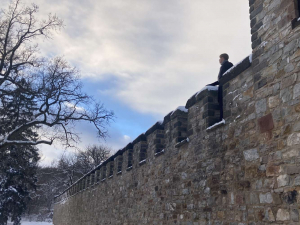

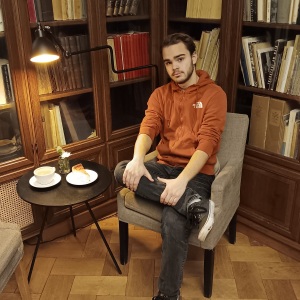

Me on the wall of a Roman Fort, Joe and I eating beans for breakfast, Philosophe Joe, and Neuschwanstein Castle.
Essen und Fressen
/in Berlin 2023Before I get to what I would like to talk about, that being food here, I have to explain the title. My grandma didn’t speak German, but before every meal, she would always say, “It’s time to eat! Essen und Fressen!” Both words mean, “to eat” in German, but “essen” is the word used to describe people eating, and “fressen” is to describe animals eating. In other words, when my grandma said this, it was always sort of a joke making fun of us, like some in my family ate like people and others like animals. It also highlights the differences in languages in a humorous manner.
Ah yes, food in Germany. I have really enjoyed it. One of the things I wish America had was Döner. It is a sort of sandwich, and the meat can be either beef or chicken, cooked on a vertical spit (similar to shawarma), shaved off the spit with a knife, and it all goes in a bread pocket with salad and savory sauces. I could definitely eat this for the rest of my life. This is a very unique part of German culture, since Döner came with the influx of Turkish immigrant workers after the World War II. It was popularized by the Germans, but comes from the Turks. A decent comparison to this food phenom would be pizza in America and Italy in the sense that America really took pizza and made it its own. There is pizza in Italy and Döner in Turkey but (I’m told) that there isn’t a whole lot of Döner places in Turkey, and the pizza in Italy (I’m also told) is not quite like American pizza.
Another aspect of German food is their sweets and baked goods. I was always more of a savory guy, not much of a sweet tooth, but in Germany, their sweets always hit the spot and I never feel bad eating baked goods. Part of this change is due to the fact that much of the bread here is very light and probably healthier than the U.S. Another reason why you can see me eating a lot of candy in Germany is because they use cane sugar in most of their sweets, as opposed to high fructose corn syrup in many American candies. It makes a huge difference! Cane sugar just taste better and more real than the other stuff. Even the sodas (pop) use cane sugar, and they are all way more delicious than what I am used to in the U.S.
One drawback is that meat is very expensive in Germany, and sometimes people will just skip that part at restaurants or at homes. It took me some time to get used to this, but I realize that not much meat is needed in a healthy diet, and I think that Americans, in many areas of life, go overboard with it since we have been incredibly blessed with a fruitful land. I would say that the food of Germany (and a few other things) has taught me how wasteful Americans can be sometimes, and I never really thought about it before.
